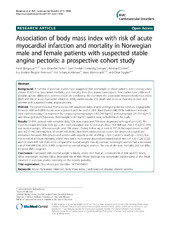| dc.contributor.author | Borgeraas, Heidi | en_US |
| dc.contributor.author | Hertel, Jens Kristoffer | en_US |
| dc.contributor.author | Svingen, Gard Frodahl Tveitevåg | en_US |
| dc.contributor.author | Seifert, Reinhard | en_US |
| dc.contributor.author | Pedersen, Eva Kristine Ringdal | en_US |
| dc.contributor.author | Schartum-Hansen, Hall | en_US |
| dc.contributor.author | Hjelmesæth, Jøran | en_US |
| dc.contributor.author | Nygård, Ottar | en_US |
| dc.date.accessioned | 2014-05-30T08:46:10Z | |
| dc.date.available | 2014-05-30T08:46:10Z | |
| dc.date.issued | 2014-05-21 | eng |
| dc.identifier.issn | 1471-2261 | |
| dc.identifier.uri | https://hdl.handle.net/1956/7938 | |
| dc.description.abstract | Background: A number of previous studies have suggested that overweight or obese patients with coronary artery disease (CAD) may have lower morbidity and mortality than their leaner counterparts. Few studies have addressed possible gender differences, and the results are conflicting. We examined the association between body mass index (BMI) and risk of acute myocardial infarction (AMI), cardiovascular (CV) death and all-cause mortality in men and women with suspected stable angina pectoris. Method: The cohort included 4164 patients with suspected stable angina undergoing elective coronary angiography between 2000 and 2004. Events were registered until the end of 2006. Hazard ratios (HR) (95% confidence intervals) were estimated using Cox regression by comparing normal weight (18.5-24.9 kg/m2) with overweight (25–29.9 kg/m2) and obese (≥30 kg/m2) patients. Underweight (<18.5 kg/m2) patients were excluded from the study. Results: Of 4131 patients with complete data, 72% were males and 75% were diagnosed with significant CAD. The mean (standard deviation (SD)) age in the total population was 62 (10) years. Mean (SD) BMI was 26.8 (3.9) kg/m2, 34% was normal weight, 48% overweight and 19% obese. During follow up, a total of 337 (8.2%) experienced an AMI and 302 (7.3%) patients died, of whom 165 (4.0%) died from cardiovascular causes. We observed a significant interaction between BMI groups and gender with regards to risk of AMI (p = 0.011) and CV death (p = 0.031), but not to risk of all-cause mortality; obese men had a multivariate adjusted increased risk of AMI (HR 1.80 (1.28, 2.52)) and CV death (HR 1.60 (1.00, 2.55)) compared to normal weight men. By contrast, overweight women had a decreased risk of AMI (HR 0.56 (0.33, 0.98)) compared to normal weight women. The risk of all-cause mortality did not differ between BMI categories. Conclusion: Compared with normal weight subjects, obese men had an increased risk of AMI and CV death, while overweight women had a decreased risk of AMI. These findings may potentially explain some of the result variation in previous studies reporting on the obesity paradox. | en_US |
| dc.language.iso | eng | eng |
| dc.publisher | BioMed Central | eng |
| dc.rights | Attribution CC BY | eng |
| dc.rights.uri | http://creativecommons.org/licenses/by/2.0 | eng |
| dc.subject | Acute myocardial infarction | eng |
| dc.subject | Body mass index | eng |
| dc.subject | Cardiovascular disease | eng |
| dc.subject | Obesity paradox | eng |
| dc.title | Association of body mass index with risk of acute myocardial infarction and mortality in Norwegian male and female patients with suspected stable angina pectoris: a prospective cohort study | en_US |
| dc.type | Peer reviewed | |
| dc.type | Journal article | |
| dc.date.updated | 2014-05-24T07:04:40Z | |
| dc.description.version | publishedVersion | en_US |
| dc.rights.holder | Copyright 2014 Borgeraas et al.; licensee BioMed Central Ltd. | |
| dc.rights.holder | Heidi Borgeraas et al.; licensee BioMed Central Ltd. | |
| dc.source.articlenumber | 68 | |
| dc.identifier.doi | https://doi.org/10.1186/1471-2261-14-68 | |
| dc.identifier.cristin | 1135860 | |
| dc.source.journal | BMC Cardiovascular Disorders | |
| dc.source.40 | 14 | |

